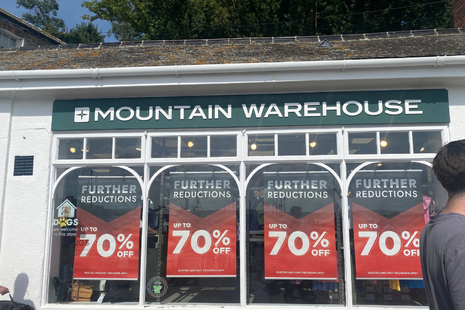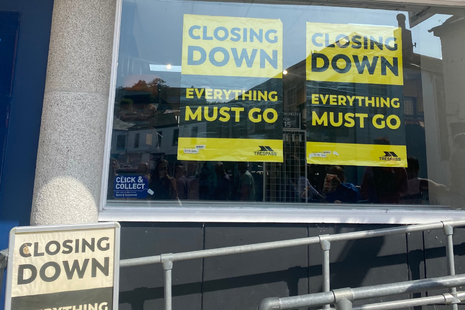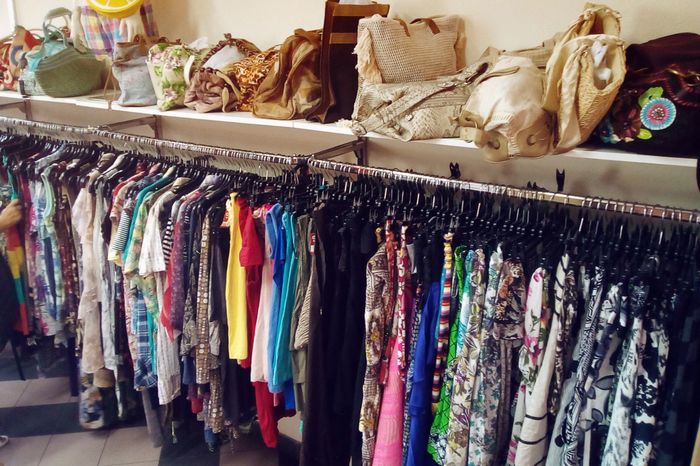Is the vintage vibe killing the high street chain?
Emma Jameson-Dake argues vintage aesthetics may be the final nail in the coffin for the high street clothing chains (and that its death isn’t such a bad thing)

The move back home for the holidays comes with many-a-woe for the fashion writer. No more people-watching in town to eye-up trends and material inspirations courtesy of the stylish Sidge-goers, no more humble brags in getting to put your Vinted delivery address as a Cambridge college, and– if you’re from a town anywhere like mine– you're met with a certain sense of despair upon returning to the graveyard that is the local high street.
The ‘death of the high street’ is a phrase that’s bounced around newspapers for years. People desperately wonder why their much adored shops are having ever more closing down sales, leaving behind a graveyard of Windolene-d shop windows. I’m sure you can imagine the tumbleweeds in your own ghostly high street. But, as depressing as the sight is, I must ask myself: when was the last time I actually bought something in one of these shops? Although I mourned the loss of my small town’s New Look in 2018 like a dearly departed lover, now its samey clothes are honestly of little appeal. With a record number of New Look closures last year, it seems as though I’m not the only one feeling the high street shift, and not the only one now decidedly ambivalent towards it. For the average Gen Z consumer, vintage is the new new, and high-street brands just can’t seem to keep up.
“I mourned the loss of my small town’s New Look in 2018 like a dearly departed lover, but now its samey clothes are honestly of little appeal”
The truth is, high street shopping just doesn’t hit the same anymore. When the same variation of whatever colours are deemed ‘in season’ stare back at you (I must confess that the lines of neon lime-green stock that eerily preceded brat summer were not to my personal taste), it’s hard to have faith in the high street.
There’s just something so much more appealing about rummaging through rails of heavy fabrics that smell musty in the best way (like old books), and coming across a gem of a piece nestled away. Ever one to romanticise the mundane, huh? The joy of nursing something old back to life creates a connection to your clothing; this cannot be established with a store-bought piece, which is ultimately just one of thousands currently on sale. Each item of your wardrobe tells a story, and vintage tells a decidedly richer one.
More and more people are getting behind the vintage vibe, as popularised on TikTok through American Goodwill hauls, which have translated across the pond into our (slightly less elegantly named) charity-shop finds. The Nike jumpsuits and floral Shein dresses of my hometown are no more – preloved denim, long skirts, and vintage jackets have certainly earned their place in the typical Gen Z closet, with charity shops and vintage stores noticing more footfall than ever.
“Retail chains hold the uncomfortable middle ground between designer quality and charity shop affordability – yet the buyer seems to lose out in both respects”
And isn’t this for the better? The remnants of my haunting 2016 Shein-era lie in the depths of my wardrobe, a tangle of loose threads and elastic stretched beyond repair. In contrast, the jacket I bought at a vintage shop comes to me after it has lived a previous life. I can imagine the old owner. Soft leather shows creases of well-worn love and the pockets contain bottle caps, perhaps remnants from many a night spent unwinding after work. The jacket still looks as good as new –better, even, than some stuff on the shelf nowadays (how are the buttons already hanging onto a new item by a thread?!). Clothing companies skip out on quality for the sake of keeping up with fast fashion trends: you need only look at the 90s Levis still worn by many on a day-to-day basis to see that £15 Primark trousers don’t stand a chance in the durability department. This is without mentioning the ethical pitfalls of of fast fashion; there’s a certain uneasiness about remembering that your polyester get-up was laboured over in conditions you’d rather not think about. With clothes wastage at an all-time high, stylishly preloved and older clothes are the way to go.

Of course, it goes without saying that such a statement comes with financial implications. Student expenses and the cost-of-living crisis mean that, for some, convenience and budget leave mass-market chains as the only option. Yet charity shops have surprisingly up-to-date stock, able to cater to the ever-changing dynamics of Gen Z trends. If you can get past the idea of someone else wearing your clothes before you, both style and sustainability factors point to vintage. There’s a pitfall in buying cheaper clothes when on a budget: it often ends up cheaper to buy one good quality piece that lasts for years, than a budget garment that needs replacing five times. Retail chains hold the uncomfortable middle ground between designer quality and charity shop affordability – yet the buyer seems to lose out in both respects.
Thanks to the rising vintage trend, more and more people are recognising the benefits of preloved clothing that speaks to the dynamic styles of the younger generation. With high-street retail on a steady decline, the choice to switch to secondhand is in the hands of every buyer. Maybe in a microcosmic way, the consumer is responsible for the deadened high street – though I for one am willing to have that death on my hands.
 News / Cambridge study finds students learn better with notes than AI13 December 2025
News / Cambridge study finds students learn better with notes than AI13 December 2025 News / Cambridge Vet School gets lifeline year to stay accredited28 November 2025
News / Cambridge Vet School gets lifeline year to stay accredited28 November 2025 Science / Did your ex trip on King’s Parade? The science behind the ‘ick’12 December 2025
Science / Did your ex trip on King’s Parade? The science behind the ‘ick’12 December 2025 News / Uni Scout and Guide Club affirms trans inclusion 12 December 2025
News / Uni Scout and Guide Club affirms trans inclusion 12 December 2025 Arts / Modern Modernist Centenary: T. S. Eliot13 December 2025
Arts / Modern Modernist Centenary: T. S. Eliot13 December 2025








